
How Long Does a Home Addition Take to Build? The Truth Revealed
Understanding How Long Does a Home Addition Take to Build and What Affects the Timeline
When you decide to expand your living space, it is natural to wonder, how long does a home addition take to build? A home addition can take anywhere from 2 months to an entire year to complete. The final timeline depends on factors like the size of your addition, structural complexity, weather events, and how quickly you can secure permits.
A well-planned home addition not only adds valuable square footage, but also helps you create a more functional environment for your daily routine. If you are eyeing new living quarters for aging parents or a spacious family room for weekend gatherings, the construction timeline can shrink or stretch based on your unique situation. Good news: knowing the key elements that shape this schedule can help you manage expectations and reduce stress.
You will see greater efficiency if the team you hire has the right experience, offers consistent communication, and submits prompt permit applications. Mazzamuto Construction, which has over 60 years of experience serving Martinez, suggests having a clear design plan upfront to keep your build on track. When you gather inspiration and organize your must-haves from the start, you avoid delays and unexpected changes later.
Key factors that influence your timeline
Several components work together to determine how long your home addition will take. Understanding these factors helps you anticipate potential slowdowns and plan effectively:
- Project scope: A small bedroom bump-out can finish faster than a sprawling two-story addition. The larger the space, the more work is required.
- Permit approvals: Securing building permits can be time-consuming, especially if your local office is backed up. Make sure you know the specific requirements in your area.
- Design complexity: Structural modifications, custom finishes, or specialty features (like skylights or vaulted ceilings) can add extra steps to your timeline.
- Weather conditions: Rain, snow, or extreme heat may delay construction. If you live in a region with unpredictable weather, pad your calendar for potential pauses.
- Contractor availability: Skilled tradespeople book up fast. If you hire a busy team, you might wait for an open spot. Once on site, experienced pros can move efficiently.
- Material sourcing: Special-order items such as custom cabinetry or unique flooring can slow your project if those materials are delayed.
By recognizing these influences, you give yourself a head start on addressing potential hurdles. For instance, if you know specialized windows take 6 weeks to arrive, you can order them well in advance. This way, there is no last-minute scramble or schedule lag.
Tips to keep your project on track
You do not have to sit on the sidelines while your contractor manages every detail. Taking an active role can help your project flow smoothly:
- Work with a reputable team: A contractor with strong credentials and decades in the industry is more likely to stick to a realistic timetable. You can explore an established option such as home additions for extra insights.
- Communicate changes immediately: If you adjust the floor plan or change a fixture, tell your contractor right away. Delays often stem from late-stage changes.
- Plan for daily progress updates: Painless check-ins ensure everyone stays on the same page. Mazzamuto Construction, for example, provides consistent progress reports, so you are never left guessing about the status of your home addition.
- Think about remodeling synergy: If you intend to upgrade your kitchen soon, pairing that project with an addition might save time. You can read more about remodeling to see how bundling improvements can streamline your entire remodel.
- Prepare for unexpected hurdles: Good contractors adapt quickly when surprises arise. But having a small contingency fund and flexible scheduling can remove a lot of stress if you hit a snag.
By following these steps, you avoid many of the bottlenecks that slow down construction. Good news: if you spot an issue early and address it together with your contractor, you often shorten the overall downtime.
The Truth About How Long Does a Home Addition Take to Build
In the end, each home addition is unique. You might see completion in as little as 8 weeks for a straightforward project, while a more complex expansion may take the better part of a year. The timeline hinges on various factors, from design requirements to material deliveries. Still, with a solid plan and a trusted team, the process can be surprisingly smooth.
If you choose to collaborate with a skilled firm that has a proven track record for quality and efficiency, you will likely finish on or even ahead of schedule. Whether you need a guest suite, a bigger family area, or a home office tailored to your routine, you can make decisions that keep construction moving at a steady pace.
Let’s Build Your Dream Addition On Time and On Budget
Now that you know how long does a home addition take to build, it’s time to make your dream home a reality. Whether you need a custom guest suite, larger kitchen, or expanded family room, Mazzamuto Construction brings 60+ years of experience to help you stay on schedule and within budget.
Contact us today to schedule a consultation and start your home addition the right way efficiently, confidently, and professionally.
Frequently Asked Questions
1. What are home additions?
A home addition is a construction project that expands your current living space by adding new rooms or extending existing ones. Additions can range from small bump-outs to full second-story builds, providing extra square footage and functionality for your home.
2. How much does a home addition cost?
The cost of a home addition varies depending on size, design, materials, and labor. On average, homeowners can expect to spend anywhere from $20,000 to over $100,000. Larger or more complex additions, such as second-story builds, usually cost more than smaller projects like a sunroom or bedroom bump-out.
3. What are the types of home additions?
Common types of home additions include:
- Room additions (bedrooms, offices, playrooms)
- Bump-outs for expanding kitchens or bathrooms
- Sunrooms or enclosed patios
- Garage conversions
- Second-story additions for maximum space
Each type has a different impact on cost and timeline.
4. How much would a 20×20 addition cost?
The cost of a 20×20 home addition varies depending on materials, labor, and location. On average, you can expect to spend between $40,000 and $80,000, but high-end finishes or structural complexities can raise this cost. Always get multiple quotes and consider permits, utilities, and design fees.
5. What is the 30% rule for home renovation?
The 30% rule suggests that your home renovation budget should not exceed 30% of your home’s current value. This helps ensure that your improvements add value without over-investing and potentially losing money if you sell your home.
Key takeaway
- Early planning and clear communication greatly reduce construction delays.
- Securing permits well ahead of time helps you avoid bureaucratic bottlenecks.
- Stockpiling materials before demolition or framing starts ensures smoother workflow.
- Weather can pose a setback, so building a buffer into your schedule helps.
- Choosing a seasoned contractor with a proven track record creates fewer surprises, saving both time and money.




